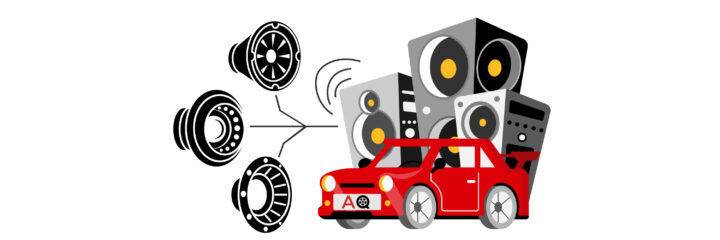A subwoofer is a pretty simple device. It’s got a cone, some copper and a big magnet. How you arrange, package, and design those parts, though, leads to hundreds of options. Choosing the right one can be a time-consuming mess of numbers and brands claiming to be the best. To combat that, we put together some tools to get you thumping asap.
- Advantages of an 8″ Subwoofer
- How to Choose an 8″ Sub for Your Car
- Top 10 Best 8-Inch Subwoofers 2025
- 1. Best Overall 8-inch Subwoofer: Rockville SS8P Powered Under Seat 8"
- 2. Best Budget 8-inch Sub: Boss Audio CXX8
- 3. Best Premium 8-inch Subwoofer: Skar Audio ZVX-8
- 4. Best Sound Quality: MTX Audio RT8PT
- 5. Best Compact 8" Component Sub: JBL Stage810
- 6. Best Low Power 8-inch Sub: Skar Audio IX-8 D2
- 7. Best Weatherproof 8" Sub: Kicker CompRT
- 8. Most Features: Kicker 11HS8
- 9. Best Dual Enclosed 8-inch Subs: Skar Audio Dual 1400w
- 10. The Most Compact 8-inch Powered Sub: Recoil SL1708
- Everything You Need to Know About Subwoofers
Advantages of an 8″ Subwoofer
There are many advantages to the very approachable 8″ subwoofer. They represent a great first step in an audio upgrade.
First of all, 8″ subs often fit into factory systems. If your car came with a sub, it’s probably an 8-inch cone. Second of all, they offer the least expensive way to get into the world of sweet, sweet bass. You don’t need a huge amp to drive them, and you don’t need giant, expensive enclosures.
How to Choose an 8″ Sub for Your Car
First up is this quick buying guide. We’ll hit all the key things you need to know. Afterward, we will hit you with our recommendations, so you don’t have to slog through pages of garbage. At the end, after the list, is a ton of information about subwoofers. It’s there just in case you want to know about the nitty-gritty or talk shop with the bass king at your cars and coffee.
Type of Subwoofer
The first thing we need to cover is the type of sub you want to buy. It is pretty general, so don’t worry about knowing about ohms, resistance, or RMS just yet. You just need to know where the sub is going to fit into your audio system design.
There are three main types, four if you include non-aftermarket options. You can dive into the fourth and learn more about each at the bottom here if you want.
- Component Subwoofers: Component Subwoofers are just speakers all by themselves. You will need a place to mount them, an amp to power them, and all the wiring to tie them in.
- Enclosed Subwoofers: Enclosed subwoofers come in their own enclosure. That’s really convenient if you already have an amp and have space to work with.
- Powered Subwoofers: Powered subwoofers, or ‘all-in-ones,’ come with an amp and an enclosure. A powered sub takes all the thinking out of it. Run some wires to it and boom, done.
Power Rating
Speakers have three primary measurements: the peak wattage, the RMS wattage, and the resistance.
Peak vs. RMS
Peak wattage is how fast you can run a mile. RMS wattage is how fast you can run a marathon. Advertisers like to show you the peak power because it’s a big number. It’s really not very important since running a speaker at peak will destroy it quickly. For more on the numbers, head down the page here.
Resistance
On a speaker, you’ll usually see a funny little omega symbol like this: Ω. That’s the ohms. Most car audio equipment is 2-ohm or 4-ohm, but some subwoofers can be as low as 1-ohm. Ohms affect sound clarity, with lower ohms producing lower-quality sound.
Matching Your Amp to Your Subwoofer
Amps will have an RMS rated at multiple ohms. Just make sure that you match both. If you don’t, you’ll have problems. Let’s say you hook a speaker rated to 200w RMS at 4ohms to an amp putting out 200w RMS at 2ohms. You’ll actually be feeding your speaker twice the energy it’s rated for, and it will blow up.
Hoffman’s Iron Law
The last piece of the puzzle for getting the best sub for your car is choosing the speaker’s style. Since this guide is only about 8″ subs, that makes it a lot easier. There is still a lot of variation, though, and there is no best answer. There is only the best answer for your situation and what you are willing to sacrifice. To determine that we have the awesome sounding Hoffman’s Iron Law of Speaker Building. It’s the easiest way to compare different speakers.
Hoffman’s Iron Law says that you can only choose two of the following:
- Excellent Sound Quality: We go over variations in sound quality here, but it’s mostly expressed in the frequency range. The lower the optimized frequency, the better the bass will sound. Typically you want less than 50hz at the bare minimum.
- High Efficiency: A sub is more efficient if it can get loud and produce good quality using less energy. In a practical sense, this is tied to cost. The more power you need, the more money you will have to shell out.
- Compact Size: Most people need a sub that fits into a confined space, so you have to balance that against the other categories. Since the diameter of every 8″ speaker is 8″, like the name implies, we’ll focus on enclosure size. A bigger enclosure means more volume and clarity.
Naturally, if you want considerable volume for cheap, you will need something gigantic or something that doesn’t sound great. If you need something tiny, you will either be sacrificing sound quality or spending a ton of mullah. You can read more about it more in-depth at the bottom here.
Top 10 Best 8-Inch Subwoofers 2025
1. Best Overall 8-inch Subwoofer: Rockville SS8P Powered Under Seat 8"
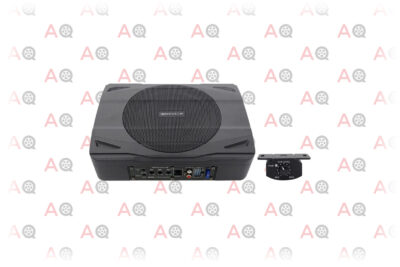
Editor’s Rating:
Sound Quality
The sound of the Rockville SS8P is fine: it’s not going to distort easily, but you will not be getting the lowest lows or best volume. You will also be missing some fullness because the enclosure is so shallow. That being said, it’s not for specific purposes: it’s designed to be a great all-rounder.
Efficiency
It’s inexpensive, runs off 100 watts RMS, and allows for high-level inputs. You won’t be selling a kidney to afford to run this unit. The downside is that you’re capped at 100 watts. It’s enough to fill out a factory system, but not to produce eye-watering bass.
Size
It’s not the smallest complete setup on this list, (that honor goes to the Recoil SL1708) but it’s close. You won’t have any problem finding a place to install it.
Verdict
The Rockville is an all-in-one, and it’s designed to be incredibly easy to install. That’s really cool. It means that anyone can get set up with a good hit of bass. They choose to focus on keeping it compact and efficient, which is also cool. Unfortunately, thanks to Hoffman, we know that means you won’t be getting top of the line sound quality or volume. If you want a little more volume in a system that’s still very easy to install, check out this MTX sub on our list.
Pros
- Incredibly convenient, you don't need an amp or enclosure
- Inexpensive
- Works with any system
- Enclosure is durable and well built
Cons
- Low volume
- Not very much control over the sound profile
2. Best Budget 8-inch Sub: Boss Audio CXX8

Editor’s Rating:
Sound Quality
The CXX8 is optimized for 49hz, which is just about the bare minimum for a subwoofer to be acceptable. The materials are cheap too, which means it’s more prone to distortion.
Efficiency
With a 600 watt peak, you can drive this little sub using just about every amp on the market. It’s cheap and can run off of cheap amps, like the ones manufacturer Boss is famous for.
Size
This sub will fit into just about any medium-sized enclosure and thrive. It’s 4″ deep, so it’s not as shallow as others like the JBL, but it’s also not a monster that needs an entire kitchen cabinet to function.
Verdict
With the CXX8, you’re sacrificing some volume and quality for a small sub that costs pennies. If you really need the ultimate in quality from an 8″ sub, you can spend a grand easy to set up some of the powerhouses on this list. Otherwise, clean out your couch and grab one of these. It is a perfect first step into the car audio world.
Pros
- Inexpensive
- High wattage rating for the price
- Very durable
Cons
- Sound quality could be better
- Wire connection points are weak
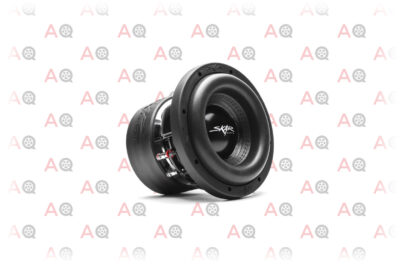
Editor’s Rating:
Sound Quality
Ultra low-frequency response, high-quality materials, and dual voice coils make this the best sounding subwoofer on this list. You will get some distortion at high volume when you drop below 30hz, but everything is relative. For a tiny 8″ sub, that little distortion is really amazing.
Efficiency
You won’t find any efficiency here. This sub is rated to 900 watts RMS. It needs more power than every powered sub on this list hooked together, and there’s nothing cheap about that.
Size
The speaker sits at nearly 8″ deep. It’s a big unit for being so small in diameter. Still, because of the ultra high-power, you can get away with a relatively small enclosure.
Verdict
Skar is a big player in the bass world; they know how to make an audiophile smile. Unlike most 8″ subwoofers, the ZVX sacrifices your wallet instead of sound quality or volume. The only way to get louder and higher quality from a sub is to step out of the 8″ world.
You will need an amp that has enough power to drive this sub, and you will need to build a custom enclosure. If you don’t need that quality, save some money and look at this much more reasonable Skar.
Pros
- Can handle massive amounts of power
- Dual voice gives you tons of wiring options
- Punches way above its size in volume and clarity
Cons
- Expensive
- Needs a serious amplifier
4. Best Sound Quality: MTX Audio RT8PT

Editor’s Rating:
Sound Quality
The MTX RT8PT is probably the best sounding powered sub on this list. MTX really focused on building a product that is simple to work with, and that doesn’t sacrifice frequency response.
Efficiency
It’s more expensive and uses more power than the Rockville, but it’s not bad. There’s nothing to complain about for a unit that comes with its own amp, enclosure and can be driven by any head unit.
Size
It’s squarely medium-sized. It won’t fit under your seat, and you won’t be able to hide in a factory cut out. It’s not too big, though, not like the Skar enclosed speakers on the list. There are just more compact options.
Verdict
The MTX is probably the closest you can get to a compromise on all of Hoffman’s metrics. It’s medium-sized, medium quality, and has a decent efficiency rating. Unlike the Rockville or the Recoil, it doesn’t go all-in on saving space. Unlike some of the higher power options like the Boss, it doesn’t go all-in to get the most volume out of a small speaker. It just tries to stay right in the center of everything.
If you do decide to go with the MTX, get an 8″ grate for the front. They did a great job making a beautiful carpeted enclosure. Unfortunately, they left the front of the speaker exposed to the elements. Spend the few extra dollars to protect it from loose objects bouncing around your trunk.
Pros
- Very easy to install
- Provides great volume for the size
- Enclosure is carpeted, designed well and sturdy
Cons
- Not as compact as other all in ones
- The speaker is very exposed and can be damaged if not protected
5. Best Compact 8" Component Sub: JBL Stage810

Editor’s Rating:
Sound Quality
With a range of 38-200hz, there’s not much to complain about. It’s not going to distort easily, and JBL is pretty well known for making great sounding audio equipment.
Efficiency
Don’t let the 800 watts on the box fool you, the JBL is only rated to 200 watts RMS. That puts it nicely in the range of most five-channel amps, and means it’s a great compromise between shelling out a ton of cash for a dedicated monoblock and the horrors of a factory sound system.
Size
It’s a bit chunkier than the Boss, but you can still get great results with a medium enclosure or factory location. We think it provides a good return on power and quality against its small size.
Verdict
The JBL is a great compromise between the low sound quality of the Boss and the crushing price of the Skar ZVX. It’s very middle of the road, afraid to take it too far in any direction. It’s not the cheapest thing, it’s not the most compact, and it’s not the best sounding, but it’s hard to go wrong for the price. If you take audio seriously but are just getting into the custom system world, this is a great sub to grow with.
Pros
- Great frequency response for the size
- JBL Sound Quality is top-notch
- Does not need much space
Cons
- More expensive than similarly built subs
- Max wattage is misleading
6. Best Low Power 8-inch Sub: Skar Audio IX-8 D2
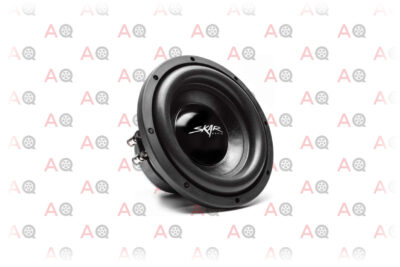
Editor’s Rating:
Sound Quality
Skar is at it again with the lowest lows on the list at 30hz. That’s amazing for an 8″ sub. Unfortunately, it’s rated for so little power that it will distort much faster than its bigger brother, the ZVX.
Efficiency
This amp is almost efficient enough to be used with a factory head unit. It has an RMS of 150 watts at 2-ohms, so you won’t need much to get that ultra-clear bass you want. Just don’t expect any kind of volume.
Size
The speaker itself is small. It’s short and compact, but you will want a bigger enclosure to take advantage of the frequency range and lack of volume, and you’ll have to buy or construct it yourself.
Verdict
The Skar IX-8 is all about the sound quality at low power. You will have to engineer a good enclosure to take advantage of that quality. The low power keeps everything in budget and offers a really approachable project, though. If you want to learn about cabinet building and get the most out of that project, this Skar is for you.
If you don’t want to learn about cabinet building, you can head to this area on the list and learn about Skar’s pre-built enclosures. There’s no shame in wanting to save time and let the engineers figure it out for you.
Pros
- Great quality for the price
- Dual voice coils mean tons of wiring options
- Inexpensive
Cons
- Power rating is low
- Needs a custom enclosure
7. Best Weatherproof 8" Sub: Kicker CompRT
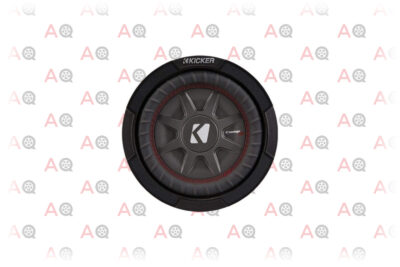
Editor’s Rating:
Sound Quality
The sound quality is decent. You can tell they tried their best to keep the lows low and clean while keeping the materials resistant and shallow. For your average rock and roll outing, it’s fine. If you plan on doing a thesis level analysis of Beethoven, stick with any of the Skar offerings on this list.
Efficiency
The Kicker Dual Shallow has a 600 watt peak and a very reasonable 300 watt RMS. That’s very middle of the range for 8″ subs, so if you want a compromise between using an inexpensive amp while still getting some good volume, this is a good choice.
Size
Size is where the Kicker shines. It’s very compact and shallow, and because it’s got decent power, it can still thump in a very confined space. It’s easy to install into just about anything. That includes boats, since this sub is rated for outdoor use.
Verdict
When you first look at this sub, you might run away at the sight of the price. Yes, it’s a very compact sub with some great power numbers, but so is the Boss on the list for less than a quarter of the price.
Two things set it apart and make it worth the price tag. First, it’s made of high-quality materials and can handle a higher load for longer periods than the Boss. Don’t get us wrong, Boss is an excellent company, but Kicker is a more serious player. Second, it’s weatherproof. You can install it on your Harley, or in your Jeep, or on your boat, and not give it a second thought as you blast tunes through the countryside when it’s pouring rain.
Pros
- Weatherproof
- Very compact design
- Higher powered than other slim speakers
Cons
- The waterproof design hurts sound clarity
- Expensive
8. Most Features: Kicker 11HS8
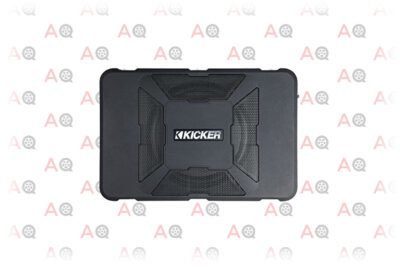
Editor’s Rating:
Sound Quality
The Kicker Hideaway doesn’t have the lowest frequency response, and it’s likely to distort at volume. However, it shines in one area: how much control you have over the sound. Unlike other powered subwoofers that focus on being simple, the Kicker 11HS8 is crammed full of features like adjustable low pass filters and phase canceling. That way, you can tweak the sound to your heart’s content.
Efficiency
Even though it has a little more power than other compact powered subs, it’s still a little on the wimpy side, especially when you consider that it costs twice as much as the Rockville. It can feel like you are paying double the money for bass that still won’t rattle your windows.
Size
Like the name implies, you can hide this sub just about anywhere. It’s only a little bigger than the Rockville. but still a lot smaller than the MTX, so you get a good compromise between the two.
Verdict
Let’s be honest here, this is just a higher quality, marginally louder and slightly better-sounding alternative to the Rockville SS8P. It has the same qualities and drawbacks: not the best sound, okay power and great size. If you are looking for something that’s just a step up from the average compact powered sub, Kicker has you covered. It’s still incredibly easy to install and convenient.
Though, the truth is that if you are willing to put in the elbow grease, you will get a better system sourcing all the parts individually and building your own box. If you don’t see yourself placing a high value on the convenience of the 11HS8, there’s a Skar 8″ component sub on the list waiting for you.
Pros
- Very easy to install
- Lots of features make it easy to dial in different sounds
- High volume for the size
Cons
- Expensive compared to other all in ones
- Bigger than other all in ones
9. Best Dual Enclosed 8-inch Subs: Skar Audio Dual 1400w
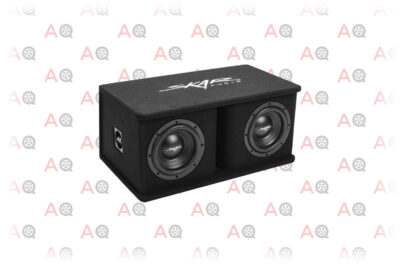
Editor’s Rating:
Sound Quality
With two high quality 30hz 8″ subs installed into an engineered enclosure, you will be getting the best sound quality that an 8″ sub can offer. The dual speaker design overcomes most of the pitfalls of a small speaker giving you mad volume without distortion.
Efficiency
It takes a ton of power to drive two subs, even if they are small. The speakers are 350 watts RMS each; even one alone takes a hefty amp to run. Together they have a 1400 watt peak. That’s getting into competition territory.
Size
When we talk about the enclosure’s size for the Skar SDR, there are two things you have to keep in mind. First, compared to a 15″ sub, it is still really tiny. The box is barely 15″ deep. Second, they are cramming two speakers into the box. That being said, this thing is two feet long, a foot and a half tall and a little over a foot deep. You are going to need a big trunk or cargo area to take advantage of a subwoofer enclosure of this size.
Verdict
It’s pretty easy to see that staying compact is not a priority with the Skar SDR-2. If you have the space, you’re getting a professionally engineered box with two high-quality subs ready to go. Just hook it up to your amp and blow the doors off.
If you are looking at the size and power requirements and thinking you could stand to scale it back slightly, the MTX we recommend might suit you better. It costs less, takes up less space, and isn’t quite as in your face. On the other hand, if the SDR-2 just doesn’t look like it’s crazy enough, Skar has you covered with the SDR-3 found over here on Amazon. No one will question your priorities when they have three tiny subs loosening their teeth.
Pros
- Huge power rating
- Enclosure is very well built
- Comes with 2 subs for full sound
Cons
- Takes up a lot of space
- Needs a big amp to power it
10. The Most Compact 8-inch Powered Sub: Recoil SL1708
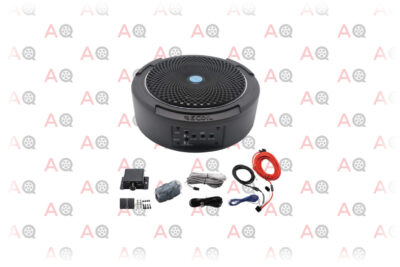
Editor’s Rating:
Sound Quality
The 40-150hz range on this sub will give you okay lows, but you’ll notice that it really kills the traditional bass range’s upper frequency. That’s fine if you gravitate towards hip hop or other percussion-heavy music, but might leave you wanting more if you are into rock or metal.
Efficiency
The Recoil is cheap. Unfortunately, even though the box says 120 watts RMS, you won’t get the volume of other compact powered amps. It doesn’t have the heat dispersion to run at high watts for long, and the built-in amp is an older style class a/b amplifier that isn’t as efficient as the Rockville’s.
Size
If the sound isn’t amazing and it’s not very efficient, it’s got to be incredibly small, right? Yes. Yes, it is. It’s just under 10″ in diameter and only stands 3″ tall. The entire unit, including amp, wires, and enclosure, is smaller than some of the individual speakers on this list. That’s insane.
Verdict
With the Recoil, it’s all about size. It’s loud enough; you will still get bass that can compete with the rest of your sound system at reasonable volumes. The quality is good enough, you probably won’t be turning it up loud enough to hear the distortion. You can hide it anywhere and install it wherever you want. If you want to have fun watching your friends freak out because they can’t tell where the bass is coming from, here’s a powered sub for you.
Pros
- Ultra-compact
- Inexpensive
- Uniquely designed
Cons
- No much control over the sound
- Low volume
Everything You Need to Know About Subwoofers
Here is the in-depth scoop on the topics from the quick guide, plus a few that weren’t.
The Four Types of Subwoofers to Buy
We said earlier that you really only need to concern yourself with the first three. That’s because the fourth could be several thousand pages of catalog space all on its own. These four categories will cover just about any style you can find in the wild.
Component Subwoofers
A speaker by itself is called a component speaker, since it’s one part of the system. It’s cheaper to buy them alone like this, especially with budget options like this Boss we recommend, but you’ll have to be more hands-on to install them. You’ll also need to do your own math to match the amp to the woofer.
The biggest advantage of buying a sub as an individual component is that you have full control over everything. Do you want to build in half a yacht’s worth of airspace? Go for it. Want to power it with a small fusion reactor? No problem, just make sure your wires are thick enough.
Enclosed Subwoofers
Subwoofers from the manufacturer in their own enclosure get you on the path towards bass town a lot faster than buying just the component. The engineers who built it already did the work to research, design, and tune the enclosure for you; all you need is an amp. Sub boxes like this two-speaker unit on our list by Skar will set you up to burst your eardrums fast.
The only issue is that enclosed subs tend to just be generic boxes that you have to fit into your car. That’s not an issue if you are willing to sacrifice all your trunk space or kick your passengers out. It can be annoying if you want to do something a bit more tasteful than having a big box rattling around in the back, though.
Powered Subwoofers
A powered sub is everything you need in one box. The amp is already attached, the box is already built, the speaker is already wired in. One of the advantages to a powered sub is that they can be ultra-compact, like this Rockville on the recommendation list. It can slide right under your seat and deliver sweet bass for no effort.
If you want any control over any of the components, though, then you are out of luck. You can’t add a bigger amp for more power, you can’t build a bigger box for more volume, and you can’t switch out the speaker for more depth. The price of convenience is steep sometimes.
Car Specific Subwoofers
This is the fourth category we told you not to worry about, and that’s because these subs are meant for a certain make and model. If your car isn’t that make or model, then they won’t fit.
Some cars have subs from the factory. If they do, then you can buy an upgrade for the factory system. Manufacturers may also make special enclosures that fit perfectly into your vehicle. Unfortunately, there are thousands of makes and models on the road. If you are looking for a specific factory sub for your car, you are better off looking at forums tailored to your car or speaking with your car dealer. If you’re not tied to a factory option, any of the subs on this list could work for you.
Watts, Ohms and Coils
When you talk about power in the audio world, you are talking about wattage. Watts themselves are a product of voltage and amperage, and they make a good unit for measuring energy. The higher the wattage, the more energy a device uses. In speaker terms, the higher the wattage, the more likely you are to lose your hearing. Easy enough.
The only problem is that manufacturers like to show you big numbers to make it seem better than it is. To get a feel for what a subwoofer can really do, you have to consider peak watts, RMS watts, resistance, and the number and size of the voice coils.
Peak Wattage
The peak wattage is the number they will shown first when measuring subwoofer power. The peak wattage is the maximum amount of power you can send to the speaker before it self-destructs. You don’t really ever want to hit the peak. The speaker won’t blow up right away, but it will definitely distort and sound like garbage. Plus, a lot of companies sort of, well, downright lie about the peak wattage.
Companies use absolutely perfect conditions in unrealistic temperatures to calculate the peak number. These lab numbers can be next to useless in the real world. Generally, cheaper subs like the Boss on the recommendation list will only tell you the peak numbers and hope you don’t look too close. That doesn’t mean they are bad. It just means you have to do a bit of digging or use this guide to give you the rundown.
RMS
RMS stands for Root Mean Square. While calculating this number is quite complex, a practical explanation is that RMS represents how much energy a speaker can put out over long periods. It’s a much more useful rating in the real world than the peak wattage.
The problem is that manufacturers will still fudge it so that the number is higher on the box. Even though a subwoofer might technically be rated to 150 watts RMS, the construction and wiring might mean it doesn’t sound as nice at that power level. That can lead to scenarios where a sub might stay louder than others despite a lower power rating. We have an excellent example in the recommendation section. The Rockville powered sub can get more volume out of 100w than the Recoil powered sub can get out of 120 watts.
Resistance
Resistance is measured in ohms which are represented by the omega (Ω) symbol. Lower resistance means more power, but higher distortion. Usually, people don’t prioritize sound clarity when it comes to bass, which is why subs usually sit at 2 ohm or even 1 ohm. People who really value sound quality will want to stick to speakers designed for it like the heavyweight Skar on the recommended section.
When it comes to comparing audio components, resistance is pretty straightforward. A speaker with 200 watts at 2 ohms will be louder than a speaker with 200 watts at 4 ohms. Sometimes manufacturers are really good at offering different resistances and configurations, like Skar, a company that’s particularly consistent with their product quality.
Sometimes manufacturers don’t even want to tell you what the resistance is. The JBL we recommend, for instance, seems to not want you to know that it’s a 4-ohm sub and not a more conventional 2-ohm sub, because that means it will be quieter than a 2 ohm. It’s not a bad sub by any means, but it illustrates that the numbers are never to be taken individually.
Voice Coils
Voice coils are the windings of copper that make up the heart of a speaker. The length, width, and size of wire all contribute to the sound quality and how much power they can handle. In general, and this is very, very simplified, a bigger voice coil can utilize more power and give you more bass. You can dive down a bottomless rabbit hole on this web page, but bigger is better for our purposes.
A component speaker with a larger coil like the Skar IX we recommend sounds better than the Boss, even though they have similar ratings and are the same diameter. The trade-off is that the Skar costs more and needs more room to install because like Hoffman’s Law points out: everything is a trade-off against something else.
Dual Coil Vs. Single Coil
A dual coil sub has more wiring and output options than a single coil. They don’t sound different, and it isn’t necessarily better to have a dual coil. You just have more room to play with wattage and resistance.
To see it better, look at the JBL on the list. It’s a single coil sub, it only has one set of posts. Take a good look at the Skar IX and you’ll see two separate sets. That means you can wire them up for 4 ohms, or wire multiple speakers in parallel.
Upgrading Your Sound System
A subwoofer by itself does wonders for a sound system, but it takes a lot more than an 8-inch sub to have a truly top-of-the line setup. Consider adding in the following products for a commercial-grade speaker system.
- Car Stereo: Along with a new sub or driver, a car stereo is one of the best bang-for-your buck items when working on upgrading your sound system. Whether you’re just looking to move up from a tape deck or you want to add Bluetooth capability and a whole host of other features, a custom, inexpensive car stereo can make a big difference.
- Sound Deadening Mats: While some cars need sound deadening mats more than others, annoying rattles and out-of-place engine noises take a lot of joy out of blasting music in your ride. sound-deadening mats can go along the way if you have an older car. Check out a list of our favorites here.
- Speakers: Subs, drivers, woofers, speakers, and more, there are many factors that play into a speaker setup. Check out our list on some of the best general speaker setups on the market.
Sound Quality
It’s always hard to talk about sound quality because it can be really subjective. Some people love ultra-clear bass that punches through the rest of a song, while others like the warmer mid-range centric tones you might find in classic rock. It’s safe to say that you want to give good volume to low notes without distortion when it comes to subwoofers. Sound quality is a combination of things. Primarily, the materials the sub is built from, the style and shape of the parts, and its construction quality.
Materials
There’s a lot of thought that goes into what type of stuff a speaker is built from. The considerations include the price, the durability, and the sound they can produce. Like with all things, it’s all about trade-offs. More responsive materials are less durable. To be durable and responsive, you need to spend a lot. It’s sort of amazing how often the “you want 3 things but can only choose 2” rules come up, isn’t it?
You can see it live in our recommendations. The Kicker we recommend is made of super durable material that can handle just about anything, but you will pay for it. If not, the Boss is also made from durable materials, but the sound quality suffers for it.
Style and Shape
Style and shape include the voice coil design, which we covered previously, but it also includes other factors, like cone depth and cone shape. The bigger the speaker, the better it is at producing low notes. The smaller the speaker, the less energy it needs. This is an area best left up to the manufacturer, with no real winner: it’s more about priorities. Each manufacturer designs their subwoofer to run a balance between frequency response range and sensitivity.
The frequency range is more useful at a glance. Typical bass notes range from 20-200hz, so the lower the sub can go, the more bass clarity you will have. On the other side, if the range is too narrow, it will clip the upper range, and you might end up with holes in your sound system.
Build Quality
Compared to the other aspects that define a speaker, this one is simple. It costs money to build a speaker using principled engineering and attention to detail, so a cheap speaker probably won’t have those things. What that leads to is rattling, imprecise responses, and premature failure. Better built speakers sound better. Seems sort of obvious, but it is important to keep in mind.
Enclosures
The science of building an enclosure is something argued about in every corner of the audio world. If you are buying something like the Skar Dual above or a powered sub, you don’t have to worry about it. If you aren’t, then space is pretty much your biggest concern.
Enclosures range from simple metal boxes to full-on fancy pants DIY projects like the one in this video. There are two main enclosure styles: ported and sealed. Ported enclosures are more for resonance. They have vents and openings so that the pressure can travel further, and they tend to be louder. Sealed enclosures are quieter but offer a more defined sound. Which you choose is all about your personal preference.
As for the design and size of the box itself, if you are going to go the DIY route, just know that you are about to do a lot of research. There’s even consumer software just for that purpose of testing different enclosures virtually. It can help to check out pages like this one that offer an overview of just how many styles and ideas there are.
Turn It Up
Whether you are just starting out on the audiophile journey or want some extra bass punch for your commute, an 8″ sub is the perfect answer. After a deep dive on the best subs on the market, the only thing left for you to do is choose one, sit down and crank the volume. Just don’t blow out your eardrums. If you do, you won’t be able to enjoy that sweet bass anymore, and life without bass is boring.
